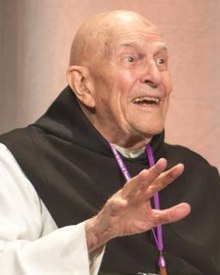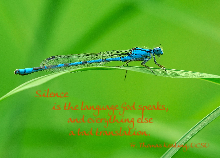2022/07/20
Entering Contemplative Worship - Friends Journal
Thomas Keating - Wikipedia
Thomas Keating
This article needs additional citations for verification. Please help improve this article by adding citations to reliable sources. Unsourced material may be challenged and removed. Find sources: "Thomas Keating" – news · newspapers · books · scholar · JSTOR (October 2020) (Learn how and when to remove this template message) |
Thomas Keating, O.C.S.O. (March 7, 1923 – October 25, 2018) was an American Catholic monk and priest of the Order of Cistercians of the Strict Observance (also known as Trappists). Keating was known as one of the principal developers of Centering Prayer, a contemporary method of contemplative prayer that emerged from St. Joseph's Abbey, Spencer, Massachusetts. [1] [2]
Life[edit]
Keating was born in New York City in March 1923 and attended Deerfield Academy, Yale University, and Fordham University.
In 1984 Keating, along with Gustave Reininger and Edward Bednar, co-founded Contemplative Outreach, Ltd., an international and ecumenical spiritual network that teaches the practice of Centering Prayer and Lectio Divina, a method of prayer drawn from the Christian contemplative tradition. Contemplative Outreach provides a support system for those on the contemplative path through a wide variety of resources, workshops, and retreats.
Keating died at St. Joseph's Abbey, Spencer, Massachusetts on 25 October 2018, aged 95 years old.
Centering Prayer[edit]
Keating was one of three principal developers of Centering Prayer, a contemporary method of contemplative prayer that emerged from St. Joseph's Abbey in 1975. William Meninger and Basil Pennington, also trappist monks, were the method's other principal developers. When the concept was first proposed by Keating, Meninger started teaching a method based on the 14th century spiritual classic The Cloud of Unknowing. Meninger referred to this as the "Prayer of the Cloud" and taught it to priests at the retreat house. Pennington gave the first retreat to a lay audience in Connecticut where the participants suggested the term "Centering Prayer". Since Thomas Merton had been known to use the term prior to this, it has been suggested the phrase may have originated from him.
Bibliography[edit]
Books[edit]
- Crisis of Faith (1979) ISBN 0-932506-05-4
- Finding Grace at the Center (1979) ISBN 0-932506-00-3
- Heart of the World (1981) ISBN 0-8245-0014-8
- And the Word Was Made Flesh (1982) ISBN 0-8245-0505-0
- Open Mind, Open Heart: The Contemplative Dimension of the Gospel (1986) ISBN 0-8264-0696-3
- The Mystery of Christ: The Liturgy as Spiritual Experience (1987) ISBN 0-8264-0697-1
- Heart of the World: Spiritual Catechism (1988) ISBN 0-8245-0903-X
- Mystery of Christ (1988) ISBN 0-916349-41-1
- Awakenings (1990) ISBN 0-8245-1044-5
- Kundalini Energy and Christian Spirituality: A Pathway to Growth and Healing, by Philip St Romain, illus. Intro. by Thomas Keating (1991) ISBN 0-8245-1062-3
- Reawakenings (1991) ISBN 0-8245-1149-2
- Invitation to Love: The Way of Christian Contemplation (1992) ISBN 0-8264-0698-X
- Intimacy with God (1994) ISBN 0-8245-1588-9
- Loving Search for God: Contemplative Prayer and "The Cloud of Unknowing,", with William A. Meninger (1994) ISBN 0-8264-0682-3
- Crisis of Faith, Crisis of Love (1995) ISBN 0-8264-0805-2
- Active Meditations for Contemplative Prayer (1997) ISBN 0-8264-1061-8
- The Kingdom of God is Like... (1997) ISBN 0-8245-1659-1
- Centering Prayer in Daily Life and Ministry, co-edited with Gustave Reininger (1998) ISBN 0-8264-1041-3
- The Diversity of Centering Prayer (1998) ISBN 0-8264-1115-0
- The Human Condition: Contemplation and Transformation (Wit Lectures) (1999) ISBN 0-8091-3882-4
- Journey to the Center: A Lenten Passage (1999) ISBN 0-8245-1895-0
- The Better Part: Stages of Contemplative Living (2000) ISBN 0-8264-1229-7
- Fruits and Gifts of the Spirit (2000) ISBN 1-930051-21-2
- St. Therese of Lisieux: A Transformation in Christ (2000) ISBN 1-930051-20-4
- Divine Indwelling: Centering Prayer and Its Development, with George F. Cairns, Thomas R. Ward, Sarah A. Butler, Fitzpatrick-Hopler (2001) ISBN 1-930051-79-4
- Sundays at the Magic Monastery: Homilies from the Trappists of St. Benedict's Monastery with William Meninger, Joseph Boyle, and Theophane Boyd (2002) ISBN 1-59056-033-7
- Transformation of Suffering: Reflections on September 11 and the Wedding Feast at Cana in Galilee (2002) ISBN 1-59056-036-1
- The Daily Reader for Contemplative Living: Excerpts from the Works of Father Thomas Keating, O.C.S.O. : Sacred Scripture, and Other Spiritual Writings (2003) ISBN 0-8264-1515-6
- Foundations for Centering Prayer and the Christian Contemplative Life: Open Mind, Open Heart, Invitation to Love, Mystery of Christ (2003) ISBN 0-8264-1397-8
- Manifesting God (2005) ISBN 1-59056-085-X
- Active Prayer: On Retreat with Father Thomas Keating (2005) ISBN 0-8264-1783-3
- Centering Prayer: On Retreat with Father Thomas Keating (2005) ISBN 0-8264-1780-9
- Lectio Divina: On Retreat with Father Thomas Keating (2005) ISBN 0-8264-1782-5
- Welcoming Prayer: On Retreat with Father Thomas Keating (2005) ISBN 0-8264-1781-7
- Divine Therapy and Addiction: Centering Prayer and the Twelve Steps (2009) ISBN 978-1-59056-144-7
- Reflections on the Unknowable (2014) ISBN 978-1590564370
Audio and video[edit]
- Contemplative Prayer (Audio, 1995) ISBN 1-56455-324-8
- The Contemplative Journey (Audio, 1997) ISBN 1-56455-537-2
- The Contemplative Journey, Vol. 2 (Audio, 1997) ISBN 1-56455-538-0
- Searching for God in America (Video, 1997)
- The Contemplative Journey (Audio CD) (2005) ISBN 1-59179-335-1
- Contemplative Prayer: Traditional Christian Meditations for Opening to Divine Union (Audio CD) (2005) ISBN 1-59179-306-8
References[edit]
- ^ Bale, Miriam (April 10, 2014). "Breaking Silence on a Monk". New York Times. Retrieved October 30, 2018.
- ^ Seelye, Katharine Q. (October 28, 2018). "Rev. Thomas Keating, Pioneer in Contemplative Movement, Dies at 95". New York Times. Retrieved October 30, 2018.
External links[edit]
- Contemplative Outreach website
- Father Thomas Keating Collection at Pitts Theology Library
- Summary of Invitation to Love
- ONE: The Movie Participation in ONE: The Movie
- Thomas Keatings' books
- St. Benedict's Monastery
- Works by or about Thomas Keating in libraries (WorldCat catalog)
- Interview with Thomas Keating on his life and Centering Prayer by ReadTheSpirit.com


